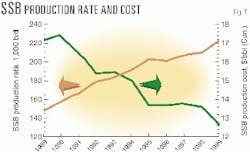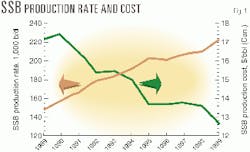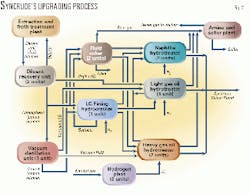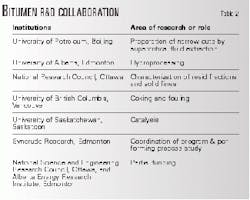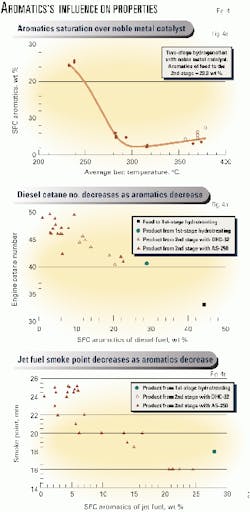Processing oilsands bitumen is Syncrude's R&D focus
Click here to view Typical product properties
This survey is in PDF format and will open in a new window
Syncrude Canada Ltd. is investing in various bitumen-upgrading research and development (R&D) programs to expand its market share and meet challenges related to bitumen upgrading.Syncrude is focusing on three areas of R&D: bitumen chemistry, process improvements, and product-quality improvements.
The company produces a synthetic crude oil (SCO), called Syncrude Sweet Blend (SSB), from Athabasca oilsands bitumen in northern Alberta.
Since the operation started up in 1978, the SSB production rate has increased from 55,000 b/d in 1979 to 223,000 b/d in 1999. The 1999 production is equivalent to 13% of Canadian crude oil consumption. Ongoing expansion projects will increase SSB production to 370,000 b/d in 2004 and to 450,000 b/d in 2007.
While production increased between 1979 and 1999, production costs decreased (Fig. 1) from $25.81/bbl (Can.) to $12.64/bbl (Can.).
Oilsands operators as well as petroleum refiners are facing tremendous challenges of increasingly stringent environmental regulations. Meeting these challenges requires more energy efficient processes to minimize environmental emissions as well as more production of environmental friendly commodities.
As the production of SCO increases to replace depleting conventional crude oil, improvement of diesel fuel cetane number (CN), jet fuel smoke point, and heavy gas oil (HGO) quality for fluid catalytic cracking (FCC) feed will be technical challenges for oilsands operators.
Syncrude's processes
Fig. 2 is a simplified flow diagram of Syncrude's current upgrading processes. Table 1 summarizes typical properties of oilsands bitumen and various distilled products from bitumen, coker products, hydrocracker products, and SSB.
Diluent-recovery; vacuum unit
Two atmospheric diluent recovery units (DRUs) fractionate diluted bitumen from the extraction and froth treatment plant. The diluent (heavy naphtha from the LC-Finer) is recovered by steam stripping and returned to the extraction plant.
The oilsands bitumen contains some light gas oil (LGO). Most of this virgin LGO is recovered and routed to the LGO hydrotreater. Part of atmospheric topped bitumen (ATB) goes to the vacuum unit. The remaining ATB goes to the fluid cokers and LC-Fining hydrocracker.
The vacuum distillation unit (VDU) was installed in 1999. It distills the ATB into light vacuum gas oil (LVGO), heavy vacuum gas oil (HVGO), and vacuum bottoms (or vacuum topped bitumen, VTB). The LVGO and HVGO are directed to the LGO hydrotreater and HGO hydrotreater, respectively, and the VTB is routed to the fluid cokers and the LC-Finer.
Current VDU capacity is 175,000 b/d. Debottlenecking will increase its capacity to 325,000 b/d in 2004 to accommodate increased bitumen production.
Fluid coker
The fluid cokers thermally crack heavy hydrocarbons to lighter products. The feeds are ATB, VTB, and LC-Finer bottoms.
The coker products are sour gas, hydrocarbon gases, liquid products, and coke. The liquid products are fractionated into naphtha, LGO, and HGO. They contain high sulfur and nitrogen contents.
The liquid products also contain a relatively high olefins (30 vol % or 80 bromine number of naphtha) and diolefins content (5 vol % or 10 diene number of naphtha) and a high aromatics content (58 wt % in LGO). The LGO therefore has a low CN (about 29).
Naphtha is treated in the naphtha hydrotreater. The LGO and HGO are combined and treated in the HGO hydrotreater.
There are two identical cokers, each originally 72,900 b/d in design capacity. Debottlenecking has increased each coker to 110,000 b/d.
The capacities will be further increased to 120,000 b/d. An expansion project will install a third coker in 2004. The third coker will be equipped with a flue gas desulfurization unit to convert sulfur off gas into (NH4 )2 SO4 fertilizer as a by-product.
LC-Finer
The ebullating-bed hydrocracker, called the LC-Finer, cracks the heavy hydrocarbons in an ebullating catalyst bed with hydrogen. The feeds are ATB and VTB. The products are light naphtha, heavy naphtha, LGO, HGO, and bottoms.
The naphtha hydrotreater treats both light and heavy naphthas. The heavy naphtha is also used as make-up diluent for an upstream froth treatment process. The LGO and HGO are treated in the LGO hydrotreater and HGO hydrotreater, respectively. The bottoms are routed to a coker.
Compared to the coker products, the LC-Finer products contain much less sulfur but a comparable nitrogen content. This means that nitrogen removal of LC-Finer products is more critical than the sulfur removal.
The design capacity of LC-Finer was originally 40,000 b/d of ATB for 60% pitch conversion. Debottlenecking has increased it to 55,000 b/d to accommodate both ATB and VTB. It will be further debottlenecked to handle 55,000 b/d of 100% VTB.
Hydrogen plant
Syncrude has three hydrogen plants. Two units produce 97% purity H2 via the steam reforming of natural gas (98.7 mole % CH4) over alumina-based nickel catalysts followed by shift conversion.
The third unit is a pressure swing adsorption plant that produces 99.99% purity H2 .
Naphtha hydrotreater
The naphtha hydrotreater (NHTU) treats the naphthas from the coker, the LC-Finer, and the HGO hydrotreaters. Coker naphtha is the main feed. The naphtha from LGO hydrotreater is sufficiently hydrotreated; hence, it bypasses the reactors and is routed to the downstream stripper.
There are two identical units in parallel. Each unit has three consecutive reactors: the diolefin reactor, the main reactor, and a small finishing reactor.
The diolefin reactor hydrogenates diolefins in the feed (mostly coker naphtha) at a relatively low temperature to prevent polymerization and fouling of the catalyst bed at the main reactor condition (OGJ, Mar. 6, 2000, p. 64).
The main reactor and finishing reactor reduce the nitrogen content to 1 ppm (wt) so that downstream refiners can use the product naphtha as a feed to their catalytic reformers with noble metal catalysts.
All Syncrude hydrotreaters use gamma-alumina-based NiMo catalysts; even the diolefins reactor uses these catalysts. Each original NHTU had a 27,000 b/d design capacity. Debottlenecking has increased each unit capacity to 37,000 b/d.
LGO hydrotreater
The feeds to the light gas oil hydrotreater (LGOHTU) are the LGOs from the DRU, VDU, and LC-Finer. The current process objective is to reduce sulfur and nitrogen. Aromatics saturation is an incidental reaction.
The feeds to the LGOHTU contain lower sulfur and nitrogen contents than the coker LGO that is treated in the HGO hydrotreater. Therefore, target sulfur and nitrogen removal can be easily achieved even with regenerated catalysts, although their activity is 20% lower than fresh catalysts.
The original unit design was 40,000 b/d. It has increased to 60,000 b/d by debottlenecking. It will further increase to 75,000 b/d and accommodate a new unit for aromatics saturation by 2004.
HGO hydrotreater
Two heavy gas oil hydrotreaters (HGOHTUs) treat coker-combined gas oil, vacuum HGO, and LC-Finer HGO. Each unit has two identical trains. Each train has two consecutive reactors: the guard reactor and the main reactor.
The guard reactor protects the main reactor catalysts by removing metals and entrained matter. The main reactor, consisting of three consecutive beds, reduces sulfur and nitrogen. Incidental reactions such as cracking and aromatics saturation also occur.
Each unit was originally designed at 45,000 b/d and has been increased to 75,000 b/d by debottlenecking. Further debottlenecking will enable each unit to treat 75,000 b/d of heavier feeds.
Syncrude Sweet Blend
Syncrude blends the liquid products from all three hydrotreaters as SSB and ships it to refiners in Canada and the US by pipeline. Unlike conventional crude oils, the SSB contains no residue. Fig. 3 illustrates typical distillation curves of bitumen, its distilled products, and SSB.
Refiners use the naphtha, LGO, and HGO fractions of SSB as catalytic reformer feed, diesel and jet fuel blending stock, and FCC or hydrocracker feed, respectively. Although the quality of each fraction meets current downstream refiners's needs, continued improvement of SSB quality is underway in response to anticipated stringent environmental regulations.
Bitumen chemistry
The current oilsands bitumen upgrading processes are based on conventional petroleum refinery know-how. Since Athabasca oilsands bitumen has some unique characteristics from conventional crude, Syncrude initiated a study of bitumen chemistry.
This approach includes a network of research groups across Canada and overseas with expertise in fuel science and colloidal properties of bitumen, bitumen processability, and impacts of bitumen on operability of process units (Table 2).
National and provincial energy research agencies, such as NSERC (National Science and Engineering Research Council) and AERI (Alberta Energy Research Institute), support this research program.
The knowledge gained from this study will allow ultimate utilization of bitumen, fine-tuning of existing bitumen upgrading processes, and development of new ones.
Supercritical fluid extraction
A novel approach to the bitumen chemistry research is the use of supercritical fluid extraction (SCFE) to prepare narrow and deep fractions (cuts) from bitumen residua or pitch (OGJ, Jan. 20, 1997, p. 66).
SCFE fractionation is based on molecular size and polarity. It cuts deep into vacuum bottoms at a much lower temperature than distillation to prevent cracking of the feedstock. It can produce sufficient quantities to allow complete characterization and process-related studies.
The University of Petroleum in Beijing prepared as many as 20 narrow cuts from Athabasca bitumen pitch by SCFE.
End cut removal
The characterization and processability test on these narrow cuts reveal that except the end cut, all the front cuts from bitumen pitch are "good" feedstock.
Table 3 summarizes key characteristics of LGO (IBP -343° C.), HGO (343-524° C.), and some 10 fractions from bitumen pitch (524°+ C.).1 The front cuts (no. 1 to no. 9) contain high heteroatoms; however, they are comparable to the Arabian Light residue in terms of molecular structures and processability.
The end cut (no. 10), on the other hand, which is about 14.5 wt % (or 13 vol %) of whole bitumen, is mostly asphaltenes and contains a high level of heteroatoms, MCR (microcarbon residue, coke precursors), metals, and clay fines.
These contaminants cause rapid catalyst deactivation. In fact, in the LC-Finer, daily catalyst addition to compensate for deactivation accounts for the highest operating cost.
Clay fines including mineral matters and salts such as chlorides are inherent to mined oilsands bitumen. The fines are coated with carbonaceous and humic matters and are concentrated in the end cut.
The clay fines in bitumen cause fouling in processing units such as the burner cyclones in fluid cokers and sour water treatment plant. Entrained clay fines in gas oils plug the catalyst beds in hydrotreaters, causing excessive pressure-drop buildup that leads to premature unit shutdown.
The chloride salts hydrolyze and cause corrosion in fractionators and heat exchangers.
If the 13 vol % end cut is removed, the Athabasca bitumen could be handled more like conventional crude oil. This opens up many alternatives in terms of process flexibility and development of more economic and environmental friendly process schemes.
Also, fouling and operability problems experienced now could be considerably reduced. Syncrude is actively pursuing the R&D program on end cut removal for incorporation in the upcoming expansion plan.
Process improvements
The R&D efforts in process improvement focus on increasing liquid product yields and unit-run length and reducing environmental impact.
The R&D programs are carried out jointly with the plant personnel and external resources (such as process licensors, universities, and national and provincial research institutions) in three key areas: fluid coking, LC-Finer hydrocracking, and hydrotreating. Research institutions include the National Research Council (NRC), the National Center for Upgrading Technology (NCUT), and the Alberta Research Council (ARC).
Fluid coking
Fluid coking advances include improved feed nozzles, reactor and stripper design, and cyclone design and reduced sulfur emissions.
- Feed nozzle. In fluid coking, multiple feed nozzles spray bitumen into the reactor. The resulting bitumen droplets mix and interact with coke particles. A portion of bitumen feed is flashed and the rest is thermally cracked into lighter hydrocarbon liquid products, gases, and coke.
R&D efforts have focused on reducing the droplet size from the feed nozzle. The concept is similar to the design of FCC feed nozzle to atomize smaller feed droplets (OGJ, Oct. 24, 1994, p. 80).
Currently, Syncrude fluid cokers are equipped with newly designed feed nozzles that provide higher product yields and increased wear resistance.
- Reactor volume and steam strippers. During recent turnarounds, Syncrude stretched the height of its coker reactors by 10% to increase the reactor volume and provide room for longer and better cyclones. As a result, the coker throughput increased and cyclone efficiency improved.
The company also modified the strippers at the bottom section of the reactor to allow better steam stripping efficiency so that carry-under of volatile hydrocarbons on the product coke is minimized.
- Cyclone fouling. Fouling of cyclones in the reactor and burner has restricted the run length. Syncrude has implemented various solutions to mitigate fouling, which have extended the coker-run length from initially 9 months to 2 years today.
Cyclone fouling is a complex process, which is a function of operating conditions and stream chemistry. Research in this area aims to achieve 3-year run length.
- Sulfur emissions. Oilsands-derived fluid coke contains high concentration (6.5 wt %) of sulfur. A portion of coke is burned to provide thermal energy for flashing and cracking the feed in the reactor. This causes sulfur emissions.
The regulated limit on sulfur emissions restricts the coker throughput. R&D programs are in place to minimize sulfur emissions.
Fundamental research on coke combustion has led to a 20% reduction in sulfur emissions. Further reductions up to 50% can be achieved with hardware modifications, planned for the future.
LC-Finer
Improvements in LC-Finer hydrocracking operations include catalyst design and furnace fouling issues.
- Catalysts. With the 1999 addition of the VDU, the LC-Finer feed became heavier, and contaminants and throughput increased.
R&D efforts focus on developing cost-effective catalysts to achieve higher pitch conversion. Syncrude is carrying out joint research with Criterion Catalyst Co. to develop better catalysts.2
Currently, a custom designed-catalyst with specific physical and chemical properties for Athabasca bitumen is used in the LC-Finer, significantly reducing catalyst cost.
- Furnace fouling. Formation of an iron sulfide-derived foulant in the feed furnace has restricted the run length of the LC-Finer. Although the plant has implemented fouling mitigation by optimizing the process parameters, more work is needed.
Hydrotreating
Hydrotreating enhances bitumen-derived products to meet environmental and downstream refinery process specifications. About 1.5 million lb (or 680 tonnes) of catalysts are loaded in all Syncrude's hydrotreaters.
For years, it has been common belief that distillate hydrotreating is a mature technology and all petroleum distillates behave similarly. Syncrude's experience, however, has shown that Athabasca bitumen-derived distillates exhibit some distinct hydrotreating process behaviors compared to conventional petroleum distillates.
For example, the nitrogen species in bitumen are relatively difficult to remove. As a result, the catalysts used for nitrogen removal from conventional crude, are not necessarily effective for bitumen-derived distillates.
To meet the challenges of higher throughput and longer run length, the R&D program has focused on stream characterization and catalysis. Syncrude has also added new feed filters and reactor internals to improve the run length.
- Stream characterization. The objective of stream characterization is to quantify the molecular species in various bitumen-derived distillates. The data show that the types of hydrocarbon molecules are similar in both bitumen-derived and conventional distillates, but the compositions in various boiling ranges are different.
As expected, bitumen-derived distillates contain a high content of aromatic species. Higher boiling point aromatics content denotes higher heteroatoms content. Also, molecules become more complex and difficult to distinguish from their functional groups.
The obscure nature of these molecules may hinder the selectivity of catalyst function, hence impacting hydrotreating reactions.
- Hydrotreating catalysis. Like for hydrocracking, Syncrude is working to develop custom designed catalysts for bitumen-derived distillates. The challenges are heavier feeds, higher throughput, and longer run lengths. Research is underway as part of Syncrude and Criterion catalyst alliance.2
- Feed filters. Plugging of catalyst bed has restricted the run length. It is caused by deposition of particulate that consists of clay fines in mined oilsands bitumen and coke fines entrained in coker distillate.
Syncrude and a filter manufacturer jointly researched and tested a new mesh-type feed filter that was recently retrofitted to the HGOHTUs (OGJ, Jan. 31, 2000, p. 70). The new filter is effective for removing micron size coke fines but is ill equipped for submicron clay fines.
Characterization of fine solids in bitumen streams is underway to better understand their physico-chemical behavior. The results will be used for developing the separation process to remove solid fines from bitumen distillates or mitigating the problem of excessive reactor pressure-drop buildup.
- Reactor internals. As the feed rates and treat and quench gas rates increased, the main reactor of the HGOHTU experienced flow maldistributions that caused uneven radial temperature distribution, resulting in poor catalyst utilization. The performance significantly improved after Syncrude replaced the internals of the two HGOHTU units during recent turnarounds.3
Product-quality improvements
Developing stringent diesel fuel regulations will require diesel with lower sulfur and aromatics contents and higher CN. As the oilsands industry expands, more SCO from bitumen will become available on the North American crude oil market.
The SCO market share could be limited, however, because of certain properties, particularly its high aromatics, low diesel fuel CN, low jet fuel smoke point, and less desirable HGO as FCC feed. Syncrude is exploring new means of producing better quality SCO.
LGO quality
Research4 5 conducted in the mid-1980s and early 1990s showed that:
- Aromatics saturation of LGO and CN has a direct relationship.
- Aromatics saturation can be expressed by reversible first-order kinetics.
- Maximum aromatics saturation over NiMo catalyst can be achieved at about 380° C. reactor temperature at typical feed rates and reactor pressures.
- The extent of aromatics saturation in the first-stage hydrotreating is limited.
- ASTM cetane index (CI) correlations (D976 and D4737) offer high bias when applied to the bitumen-derived streams.
For example, calculated CI by D976 is about 8 units higher than actual CN for coker gas oil. Syncrude developed and successfully used a new CI correlation for bitumen-derived LGOs for SSB marketing and expansion studies.
Reducing aromatics to increase the CN is an incidental reaction in the current LGOHTU operation. Syncrude has explored process conditions to improve the diesel CN from the current 34 to 40+ and the jet fuel smoke point from the current 15 mm to 18 mm.
In this regard, researchers conducted comprehensive two-stage hydrogenation pilot plant tests over NiMo catalyst in the first-stage to reduce sulfur and nitrogen to less than 10 ppm(wt) and to saturate aromatics down to 5 wt % in the second-stage reactor over noble metal catalyst6 and NiW catalyst.
Figs. 4a, 4b, and 4c6 show that maximum aromatics saturation occurs at 300° C. with a noble metal catalyst and that a diesel CN greater than 45 and jet fuel smoke point greater than 22 mm can be achieved by reducing aromatics to 5 wt %.
Syncrude decided to install a new two-stage LGO hydrotreater in 2004 as part of its ongoing upgrading expansion project.
Syncrude recently developed improved diesel CN and jet fuel smoke point correlations using narrow cuts from various bitumen-derived distillates (OGJ, Nov. 20, 2000, p. 58).
HGO quality
Future SCO market expansion also requires improvement of HGO quality. In the late 1990s, Syncrude evaluated various HGOs in a riser FCC pilot plant (OGJ, Jan. 19, 1998, p. 43).
The studies concluded that Athabasca oilsands bitumen could produce quality FCC feeds by choosing appropriate processes. A development study is under way to implement a process to improve HGO quality by 2007 in the next stage of the upgrading expansion project.
Acknowledgments
The authors thank Vince Nowlan and Maja Veljkovic at Syncrude Research for their valuable discussions and comments in preparing this article and Syncrude Canada Ltd. for its permission to publish it.
References
- Chung, K.H., Xu, C., Gray, M., Zhao, Y., Kotlyar L., and Sparks, B., "The Chemistry, Reactivity, and Processability of Athabasca Bitumen Pitch," Reviews in Process Chemistry and Engineering, Vol. 1, 1998, pp. 41-79.
- Smart, M., Shiflett, W.K., and Trevino, C.A., "Managing Catalyst from Cradle to Grave," Proceedings of the 15th Word Petroleum Congress, Beijing, 1997.
- Bingham, F.E., Chan, E., Mankowski, T., and Hubbard, P., "Improved Reactor Internals for Syncrude's HGO Hydrotreaters," 2000 NPRA Annual Meeting, San Antonio, Mar. 26-28, 2000.
- Yui, S., and Sanford, E., "Kinetics of Aromatics Hydrogenation and Prediction of Cetane Number of Synthetic Distillates," 1985 Proceedings-Refining Department, Washington, D.C., American Petroleum Institute, 1985, pp. 290-97.
- Yui, S., and Sanford, E., "Kinetics of Aromatics Hydrogenation of Bitumen-Derived Gas Oils," Canadian Journal of Chemical Engineering, Vol. 69, 1991, pp. 1,087-95.
- Yui, S., Barthel, R., and Kokayeff, P., "Kinetics of Aromatics Hydrogenation and Hydrocracking of Synthetic Middle Distillates over Noble Metal Catalyst," 1997 AIChE Spring National Meeting, Houston.
The authors
Sok Yui is a research associate at the Edmonton Research Centre of Syncrude Canada Ltd. Prior to joining Syncrude in 1979, he was section head of manufacturing coordination and planning at Mobil Sekiyu and its refining company, Kyokuto Petroleum Industries in Tokyo. Yui holds BS, MS, and DEng degrees from the University of Tokyo, all in chemical engineering.
Keng H. Chung is a research associate at the Edmonton Research Centre of Syncrude Canada Ltd. He also is an adjunct professor of chemical engineering at the University of Alberta and the University of Petroleum in China. He holds a BS, an MS from Queen's University, Kingston, Ont., and a PhD from the University of Calgary, all in chemical engineering.
This article is based on a presentation at the ITIT International Symposium on Utilization of Super-Heavy Hydrocarbon Resources, Tokyo, Sept. 18-19, 2000.
